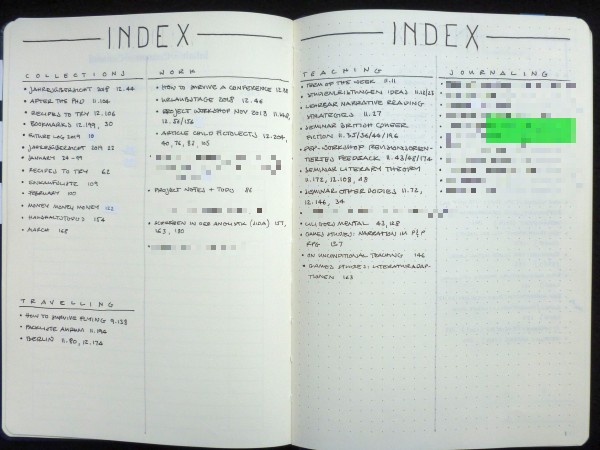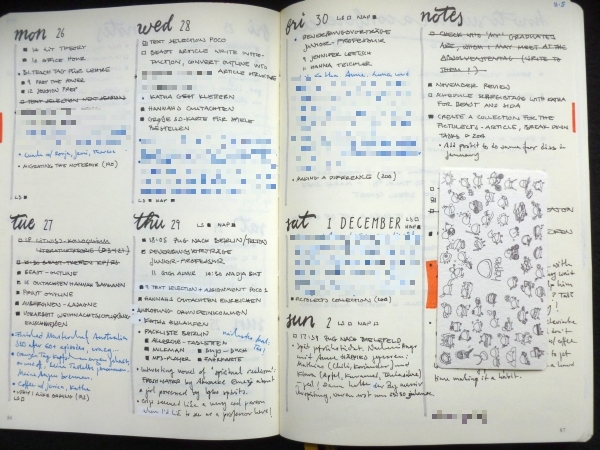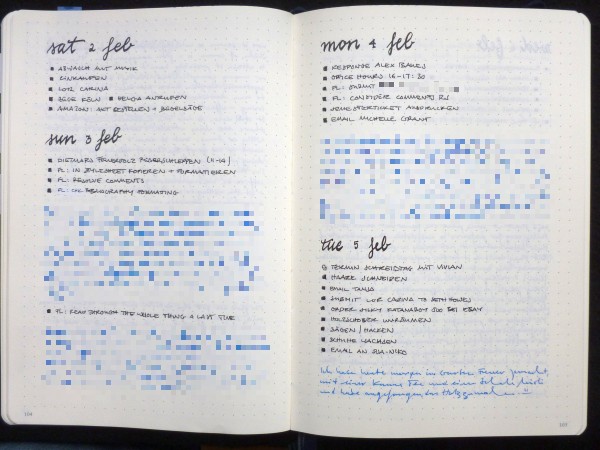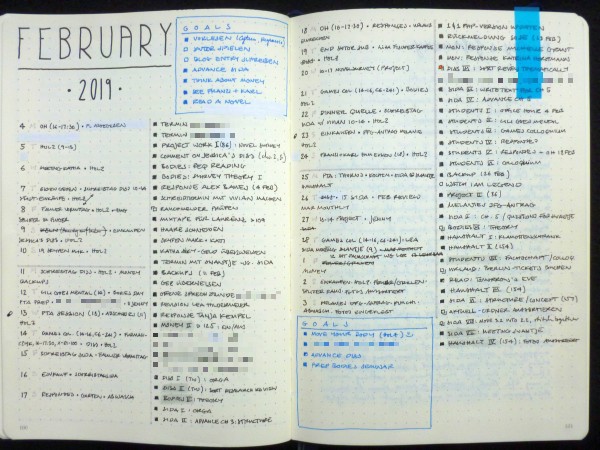Bullet journaling 2: Specific techniques I use
In the previous entry, I have written about how bullet journaling has helped me to gain a better sense of control over my work and how it gave me a better sense of self. In this more technical entry, I will discuss some of the specific techniques I use in bullet journaling, which may be of interest to other journalistas (if you’re not, most of this will probably be gibberish for you).
Using a categorized index
The normal bullet journal index is just a consecutive list of your entries as they happen with page numbers and page ranges behind it. But that can become confusing if the journal contains a wide variety of specialized entries which I want to be able to access quickly.
I divide the index into categories, like mini-collections. Meaningful categories for my journals, as you can see on the image below, are for example ‘Work’, ‘Teaching’, or ‘Journaling’ (mostly personal notes, but I also index calligraphy here). I also have, on the next page, an index category ‘Media Log’ where I index my notes on novels, films, or TV shows.

It will take some trial and error to find meaningful categories that are broad or specific enough for you. In my last Book, I had an index category ‘Doodles/Calligraphy’, but I don’t draw enough stuff in the three to four months until one Book is filled to warrant a dedicated index category. So, I merged that category into ‘Journaling’ in the recent Books.
Using daily logs instead of weekly spreads
Most BuJo examples on the internet feature elaborate weekly spreads, i.e. all the days of the week on one page in a tabular layout. This is the format that I used, too, when I began bullet journaling, because it resembles common forms of planners and gives a lot of information on a glance. The following image shows my weekly spread for the last week of November 2018:

You can see tasks and notes in black for each day, blue text is the colour of diary notes (which I have pixelized). Compare this to my current use of daily logs, where every day takes up as much space in the book as it needs, without artificial constraints:

I used to think that the benefit of the weekly spreads, i.e. to see the entire week on one glance, trumped all other considerations. But after I switched to daily logs, I quickly found that the additional space I gain by not being constrained to a fairly small box per day is invaluable: I suddenly took more (and more useful) notes and journaled a lot more, often for pages upon pages.
The key is to see the daily log as a container for everything, as a brain dump. Previously, any time I wanted to take long-form notes on a topic, I had to create a separate collection for it on the first free page, which was a hassle and disconnected it from its temporal context. Now, I just add them in the daily log and if they are worth remembering or reviewing I create an index entry for them.
Here’s a list with examples of stuff that I just dump into the daily logs, appended to the bulleted tasks list:
Notes on work-related conversations, insights, ideas (with a title and indexed in the appropriate category, see above) 1
Notes with future relevance (tasks, events, deadlines, plans) which require later review and migration (not indexed)
Diary-like personal notes, one sentence to several pages long (usually not indexed, except when relating to a recurring and important issue)
Hobby stuff, like notes on songs for music mixtapes I plan to create (indexed when future reference is desirable)
Notes on books, films, TV shows, video games (indexed because as a literary scholar, most media that I consume for fun is potentially of professional interest and my notes are often mini-analyses)
Doodles, calligraphy and drawings, etc. (sometimes indexed, mostly not)
Clustering tasks in the monthly task list
With the switch from weekly spreads to daily logs I also started to use the monthly log more because I absolutely needed an overview of weekly appointments and a collection of tasks which are relevant for a given month. Because in my work I do so many different complex things, I have a lot of tasks for every week, so that any list can quickly become unwieldy.
I solved that by a concept which I call clustering. Any task we do is usually part of a larger category which involves not only this one task but many more related tasks. For example, the research project I work in involves surveying certain novels for specific features: this endeavour involves a large number of sub-tasks, which I think of as the cluster of tasks in the category ‘Project’. Or, another example, a list of household chores which need to be done is a cluster of tasks in the category ‘Housekeeping’.
Now, I create dedicated collections in my journal for those clusters, like for example:
Housekeeping:
• Get rid of the old bedroom shelf
• Check smoke alarms
• Repair my bike
• Sort out old clothes
• Old clothes to secondhand shoplet’s say this collection lives on page 154 in My Book
When I know that I want to take time to work on the cluster, I create a non-specific task (or ‘reference task’) in the monthly task list:
• Housekeeping I (154)
During the month I check the cluster (on page 154) and prioritize and schedule one of the tasks for a specific date. After it is done, I tick it off in the cluster. I also change the entry in the monthly task list and, this is the important bit: I immediately add a new reference task:
X Housekeeping I (154): Bike repair
• Housekeeping II (154)
Of course, if a certain task has priority, I can make the reference task specific and schedule it for a certain date as soon as I enter it into the monthly task list. But many of my clusters don’t really work like that: Many of my tasks are ‘do whenever convenient, some time this month’, so that over the course of the month I constantly have to revisit the clusters and prioritize tasks on the go.
I use housekeeping as an example here because everyone has a good idea what the cluster for this category can involve. I use the clustering technique for the various research, writing, and teaching projects I have ongoing, but also for categories like ‘Students’ (the cluster contains papers to grade, office hour appointments, and admin).
The benefits of this system are three-fold: a) It keeps the monthly task list neat and the tasks are easily recognizable by context. b) The consecutive numbering shows me how much I have worked on a certain cluster, so that I can tweak my priorities if necessary. c) When I complete a task and immediately add a new reference task, I’m motivated to continuously work on what is important to me.

Yearly Memory Log
Some of my friends have incredibly good memory for things that happened years ago. I don’t. While they remember what I said and did, I struggle to remember specifics about my last vacation, let alone what I did six months ago. I never liked that about myself: That even important past experiences became kind of vague and difficult for me to locate in my lifetime, and that I drew blanks where people close to me remembered very specific things.
So, one of the most important pages in my Books is a spread where I collect activities or events that I want to remember for each month. I restrict the space to one spread for the entire year (so six months per page), so that it can be reviewed and taken in easily.
The entries read somewhat like this:
JAN 2019: played SWTOR – journaled a lot – concluded Literary Theory seminar – submitted child-fictolects article – read a lot – depression/insomnia – …
FEB 2019: cut a huge pile of firewood :) – got a lot of work done: [insert some specifics] – epic Primetime Adventures session with colleagues – thought about money [page reference with notes] – enjoyed the first sun – read a lot – …
Simple. I avoid logging negative things that happened except when they were defining for the month, but even then I write them down with a light grey pen.
2018 was the first year for which I did this and it was a great experience: I could feel the connections in my brain strengthening and my memory improving. Thinking about what to put in the memory log was an important part of the monthly reflection, and it gave me an immediate feeling of connection to myself. The Memory Log is a page that I review often and which gives me a lot of joy.
-
Working notes: For formal occasions like meetings or conferences, I take notes on separate paper because it’s easier to work with later when I can file it in a dedicated binder. ↩︎
Kommentare
Füge einen Kommentar hinzu